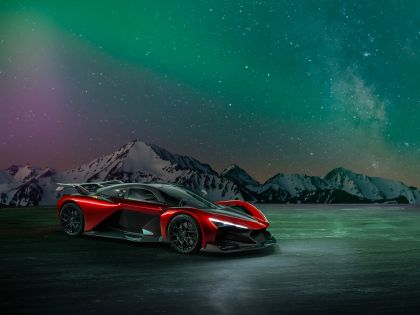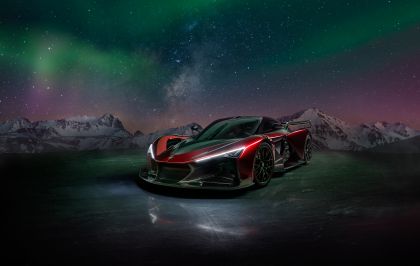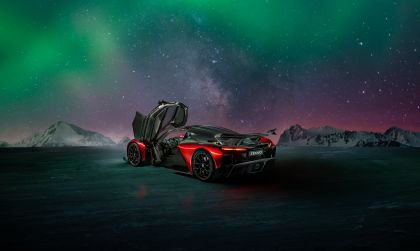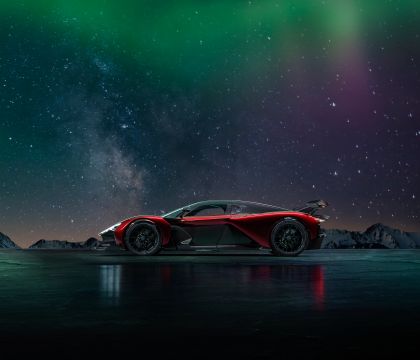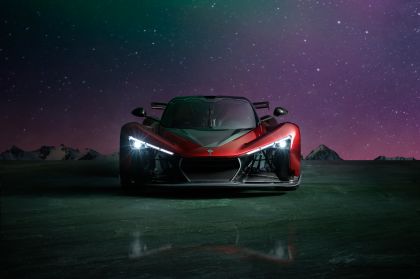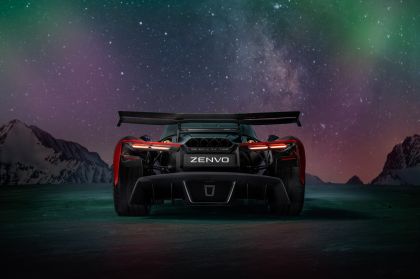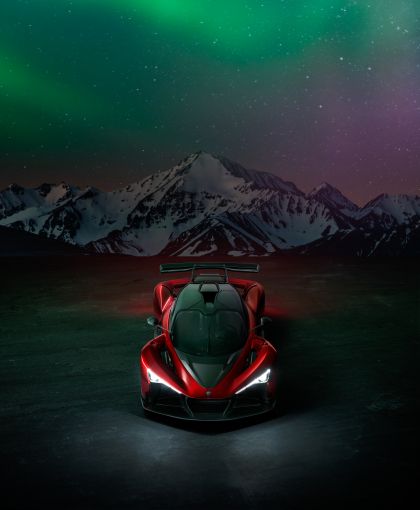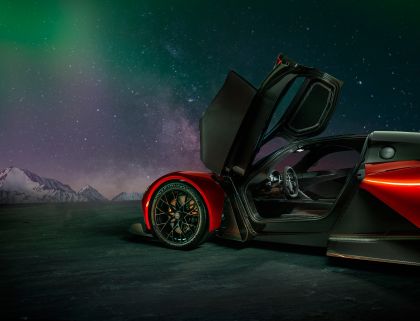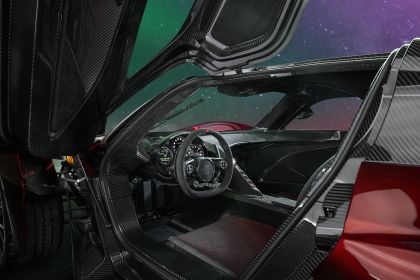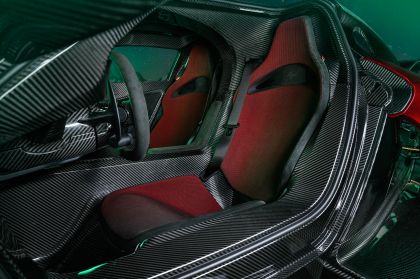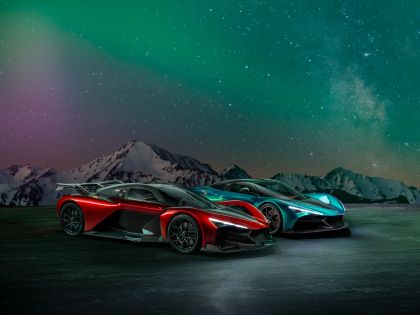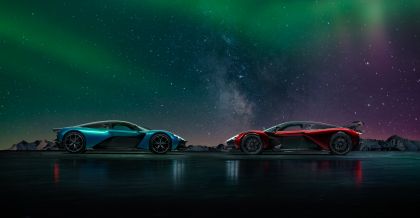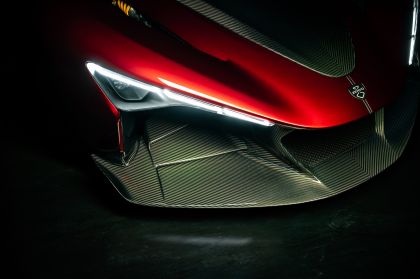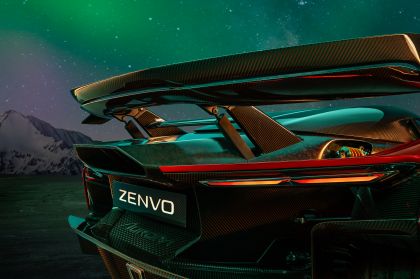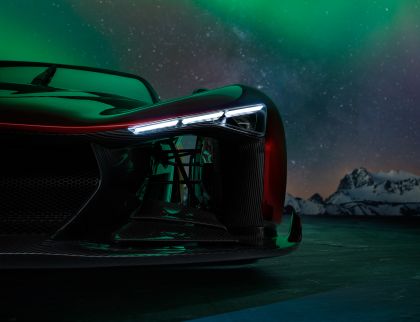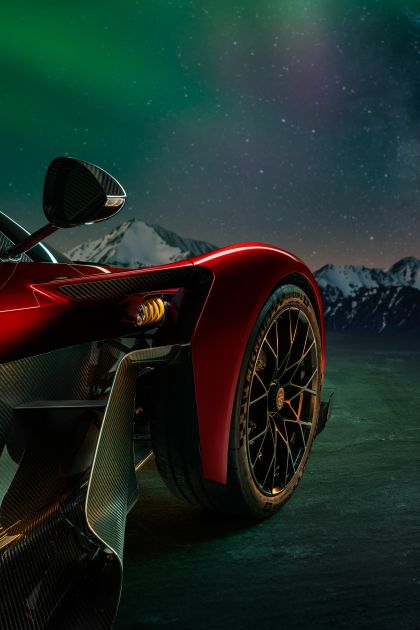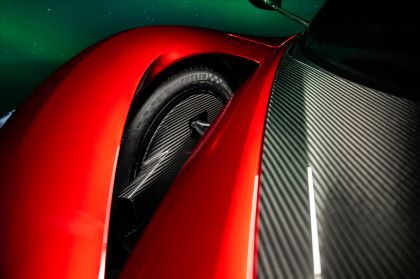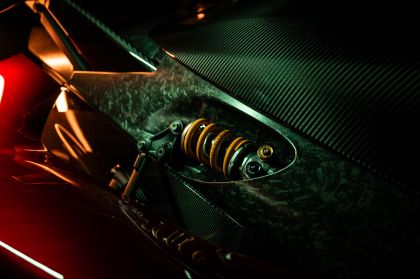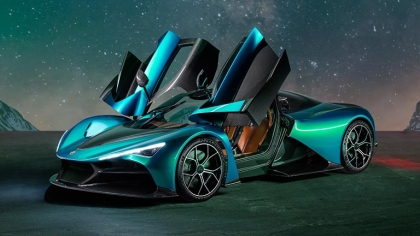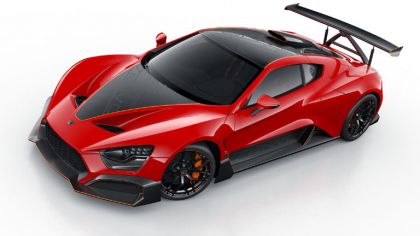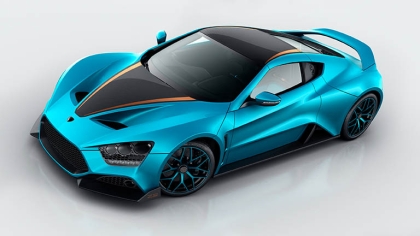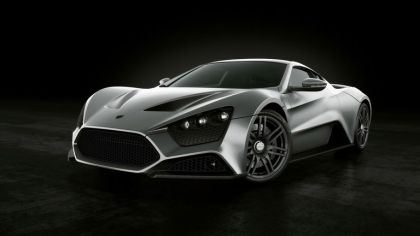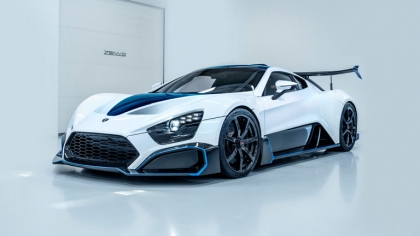- Aurora is the lightest and most powerful Zenvo model ever produced
- Two distinct and purposeful derivatives – Agil and Tur – launched simultaneously
- Translated from Danish as ‘Agile’ and ‘Touring’, both models are inspired by famous ‘form follows function’ design language
- A clear focus throughout the Aurora programme has been on innovation, without any compromise or trade off
- Designed in-house by Chief Designer Christian Brandt, Aurora brings Danish design and ingenuity to the hypercar market for the first time
- MAHLE Powertrain-developed 6.6-litre quad-turbocharged V12 engine combines with a lightweight electric motor to produce the most powerful V12 engine ever fitted to a road car, generating up to a combined 1,850bhp
- Mid-engined hybrid V12 layout, with both two- and four-wheel-drive drivetrains offered, can travel 35kms on pure electric power
- Aurora can achieve the 0-62mph (0-100km/h) sprint in as little as 2.3 seconds, and on to a top speed of 280mph (450km/h)
- Aerodynamically aggressive Aurora Agil model features stripped-out cabin and rear-wheel drive system as standard, tipping the scales at 1,300kg (2,866 lbs)
- The more classically styled Aurora Tur provides increased levels of luxury, while high speed stability and grip levels are enhanced with addition of two further electric motors on the front wheels, each providing 200bhp, and offering permanent four-wheel-drive
- Bespoke suspension system features pushrod front and rear double wishbones with active springs, offering instant adjustment to ride stiffness and support
- Lightweight chassis utilises Formula 1 technologies and processes, channelling the airflow through the structure to aid downforce and stability
- Limited to just 50 examples of each model
- Production to commence in 2026
- First appearance of Zenvo ZM1 modular carbon monocoque system, which will evolve into the second generation of models to be hand-assembled in Denmark
Newly unveiled on the eve of Monterey Car Week, the Zenvo Aurora is a milestone moment. Aurora marks the lightest and most powerful road car Zenvo Automotive has ever produced, while also marking the start of a new era for the Danish brand, with a ground-up, all-new design of hypercar, with a genuine no compromise approach to performance.
Named after and the lightweight, fast, and beautiful nature of the rare light phenomenon, Aurora Borealis, the Zenvo Aurora is designed with driving pleasure in mind. An unfiltered connection from the driver seat to the road.
Built on an all-new ZM1 modular monocoque design from Zenvo, developed with carbon structure experts Managing Composites, every parameter is maximised to the threshold of limitations and compromise. As such, and to ensure no compromise between comfort and track focus, Aurora launches with two different approaches launched simultaneously. Each meet the uncompromising brief, while offering owners the option of which style of driving and design they prefer. The aggressively styled Aurora Agil is complimented by the beautifully elegant Aurora Tur.
Both models feature a flowing, aerodynamically led, chassis design, managing and channelling airflow cleanly over, under and through the structure itself. The clean lines of Tur are a grand touring variant, with a beautifully sculpted exterior and dynamics set up for stability and comfortable road driving. In contrast, the Agil bodystyle follows the same simplistic and elegant design philosophy, but is a more extreme translation, as the bodywork cleverly manages airflow. This delivers high levels of downforce, with a clear focus on track driving.
The clear target for the project has been to ensure Aurora delivers a true drivers’ car, rather than chasing numbers or focused on outright performance. The result is an uncompromised ideal which is, in itself, very Danish by design; simplistic, sculptural, efficient, and truly employs the design philosophies of ‘form following function’ with inspiration from Arne Jacobsen’s use of negative space. Every element has been thoroughly considered, every item serves a purpose, nothing is superfluous. An absolute focus on useability and driving pleasure ensures that every owner can enjoy each experience, no matter how short or extended, behind the wheel of Aurora.
“The Aurora project is best described as an equilibrium of extremes,” explains Chairman of the Board & Chief Commercial Officer, Jens Sverdrup. “Throughout the development phases, we have been very clear that we did not want to be chasing specific numbers or laptimes, as this can then cause a distraction or compromise when it comes to other areas. However, what was important, was the drive to push the Aurora to be on the leading edge of what could be achieved through pushing each element to the maximum in synchronisation with the others. We just wanted to build an uncompromised drivers’ car, which delivered on every level, but without any one aspect negatively impacting another. It was approached in a very Danish way, meaning every part is carefully considered, and we wanted to introduce this style and design philosophy to the hypercar segment. The outcome has given us two models, which complement each other, deliver true driving pleasure and, almost as a by-product, offer incredible performance.”
DESIGN
Danish design is globally recognised for its stylish simplicity and clean lines. The philosophy of ‘form follows function’, made famous through the elegant designs of designers such as Arne Jacobson, is a language that transcends industries and genres.
Now, for the first time, this honest and logical approach has been used by Zenvo in the hypercar market, as the Aurora models showcase the principles in two different ways.
Chief Designer, Christian Brandt, headed up the small team responsible for bringing Danish design to an all-new marketplace, building on the Zenvo legacy, and foundations for future models are set out. “At Zenvo, we have some very clear design cues, which are carried forward with Aurora, and the new design language pushes the limits of what we could do with the packaging and aerodynamics. We have also been very focused on ensuring that we kept things Danish – less is more, and very simplistic.
“The chassis and the components of Aurora are all works of art, and we made a very definite decision that we did not want to hide these details away under a monolithic design. It is like a complex timepiece or the skeletal architecture of a motorcycle, where the inner workings are the fascinating part, and we wanted to showcase as much of the chassis, the engine, and the suspension as we could.”
The Agil and Tur models clearly complement each other. Built around the same base architecture, designed to work alongside each other with key styling cues, each also stands alone as an individual design, serving a specific purpose in its own right. “As we progressed further through the programme, it became clear that one model design could not fit the bill for our ‘no compromise’ approach, as one size doesn’t fit all when it comes to hypercars. Talking with a variety of owners and collectors, and taking their advice and feedback on board, it identified that there are two distinct groups, whether the cars are driven or added to a collection. There are those who want comfort and luxury, combined with stability at high speed and the ultimate GT car, versus the other group who want high adrenaline, aggressive, track focused and firm,” adds Jens Sverdrup. “The most interesting piece of data we found within our research was that this split is exactly 50/50.”
Christian explains: “The Agil design was created first, working with a very logical and uncluttered approach to the complexities of aerodynamics. The outcome is a very Danish solution to managing air flow and generating downforce, which it does extremely effectively.”
The Tur delivers the same unwavering performance, but in a much more subtle and elegant manner. “It is more of the ‘iron fist in a velvet glove’ approach with the clean, unassuming, but purposeful lines, but the final shape was something that came about very naturally,” adds Christian. “Once we had decided on two models, the Tur almost seemed to appear as the natural design – stripped back to the raw elements, with the bodywork looking as if it is simply draped over the chassis in places.
POWER
The heart of all Aurora models is the 6.6-litre quad-turbocharged V12 engine, developed by MAHLE Powertrain. Producing 1,250 bhp and revving to 9,800rpm, this bespoke powerplant is a 90-degree hot-V configuration, mid-mounted behind the cockpit. It is then enhanced further by a lightweight electric motor system, generating up to an extra 600bhp depending on drivetrain configuration. The rear wheel-drive system in the Agil features a single integrated electric motor, generating 200bhp, while the four wheel-drive set up- standard on the Tur and optional on the Agil – adds a further electric motor to each of the front wheels to offer 1,850bhp.. The result seamlessly blends instant power and torque, delivering naturally aspirated engine-style throttle response, and make this powertrain the most powerful V12 engine ever fitted to a road car.
The engine will benefit from the use of MAHLE Jet Ignition® system, which has been incorporated into the design to enable the engine to operate without the need for over fuelling for component protection (λ=1) across the entire engine operating range. This has become a requirement for the newly announced Euro 7 legislation. The all-aluminium construction along with Zenvo’s carbon fibre expertise will deliver an overall compact and lightweight unit, weighing less than 260kg (575 lb).
Fitted with a seven-speed hybridised gearbox, generating 150kW of power, the unit integrates an electric reverse and engine start in place of a traditional start motor providing weight and efficiency gains. The single shaft gearbox makes gear changes smoother, while electronic gear shift dampening can be adjusted via the controls in the cabin. Bespoke gearing and gearchange mapping will ensure that the gearchange characteristics for the two models will differ dramatically. Agil will feature very involving, more mechanical gearchanges, similar to a sequential gearbox familiar to more track focused models. Tur, on the other hand, will be a much smoother transition through the powerband.
The transmission includes an e-differential, while each of the e-motors produces 150kW of power. With one motor mounted within the gearbox in both drivetrain configurations, a further motor is then located on each of the front wheels for the four wheel-drive setup. The front motors act as an electric torque vectoring system, generating an output in the region of 400kW. Combined, the e-motor arrangement generate between 200bhp and 600bhp of instant power, acting as ‘torque fill’ while the turbos spool up. This was an important feature in the driveability of Aurora, Jens Sverdrup explains: “The overwhelming feedback we received from owners was that everyone loves the throttle response of naturally aspirated engines, and the instant hit of power delivered by electric, but without the heavy weight and range anxiety that comes with batteries. Throttle feel and responsiveness were a major focus for the whole team, and a significant amount of work has taken place on the dynamics, and the integration between the electric motors and the engine, to make this as seamless as possible. This is also the reason why the powertrain features four smaller turbos, rather than the more conventional two. It means they can spool up quicker, and the end result is a powertrain that brings together the best parts of conventional internal combustion and hybrid technology. Aurora will offer a more direct and better throttle response than an NA engine, but both Agil and Tur will feature different mapping to give different drive characteristics.”
Built around the same chassis and powertrain, the Agil and Tur are set up very differently, with a separate focus for the drivers. With a more aerodynamically aggressive stance and profile, Agil is the lighter weight, more track focused model, featuring underbody aerodynamics and a high-level rear wing with air brake function. The drivetrain sends all power through to the rear wheels as standard, while a four-wheel drive option is available. The inside of the cabin is stripped of comforts and unnecessary luxuries, with the carbon chassis exposed in several areas, while ultra-lightweight technical material is used to upholster the seats and select sections of the doors and dashboard. With this weight-saving approach, the Agil weighs in at less than 1,300kg (2,866 lb). The more aggressive design delivers enhanced levels of downforce, producing 880kg (1,940 lb) of downforce at 155mph (250km/h), and a top speed of 227mph (365km/h).
The elegant lines of the Tur manage the flow of air over, under and through the monocoque extremely efficiently, creating a more efficient flow through the air with a lower drag co-efficient than its more track-focused sibling. Underbody aerodynamics are complemented by active rear wing ducts, providing enhanced stability levels. Beyond this, the design combines with a standard four-wheel-drive system, adding to the grip levels, and much easier access to harness and exploit the power available. While the addition to the drivetrain increases the overall weight by 150kg (330 lb) to around 1,450kg (3,197 lb), the more aerodynamically efficient shape will accelerate on to a top speed of 280mph (450km/h). The cabin is appointed with high specification, tactile materials and increased levels of sound proofing, producing a more traditional luxury GT environment for the occupants, hence the name ‘Tur’ – Danish for ‘Touring’.
EMOTION
Emotion is an unmeasurable feeling, but it is something everyone experiences. Much like the Aurora Borealis, which gives its name to the latest Zenvo project, emotion results from specific factors, blending in the right way, at the right time. And, as with the majestic northern lights which light up over Zenvo’s homeland, the waves of emotion delivered by driving affect everybody differently. It was this individuality that became extremely clear during the research and fact-finding element of the Aurora programme. Owners and collectors were asked for what they are truly looking for, and what truly would stir the senses. The result of these discussions? Zenvo listened.
Armed with the ‘ideal’ requirements, the direction taken by the Zenvo team was handled with a very Danish approach. “Innovation and ‘out of the box’ thinking were key to the processes, as we don’t have everything available on the doorstep,” recalls Jens Sverdrup.
“We had to find different solutions out of necessity, and it was a clean sheet of paper to create what was the best drivers’ car without any restrictions. With that brief, we looked at all the parameters we wanted to achieve, and set about pushing each element to its absolute maximum without any adverse effect on the others.”
The overwhelming response regarding the powertrain was the pure passion and emotion delivered by a V12. It should have the instant torque offered by the latest breed of electric hypercars, but it needs to have a real soul. Through the pioneering approach of MAHLE Powertrains, the powertrain now delivers instant performance, via the electric motors, while the decision to run with four smaller turbos – as opposed to two larger units – means they spool up quicker, delivering power in a much more linear fashion. Each of these technical decisions was based on the target of achieving a throttle response as would be expected from a naturally aspirated engine.
Translating emotion into engineering is no easy task, however. The task of taking the valuable feedback and opinions on feelings, and transferring this into tangible dynamics on the road, was one challenge which the Managing Composites team faced. “Everything we have created with Zenvo is created under the mentality of ‘smiles per mile’, and we had to work hard to take the findings from the customer research and deliver something that matched up. We found that, in order to achieve our targets, we had to challenge the status quo of the hypercar industry, and look at ways of moving the needle,” explains Alejandro Batan, Chief Programmes Officer, Managing Composites.
“The Aurora project started with a blank sheet of paper and a clear focus on what we wanted to achieve. This had its own challenges, as we didn’t have a base product to build on, but it was also a fantastic opportunity as it meant we could design and create the absolute best product, using the latest technologies and systems, with no carried over compromises or limitations. This fact has meant that the Aurora project has pushed boundaries at every stage – it wasn’t a case of taking items, components or systems off the shelf. Instead, the team has challenged what is possible from suppliers, working on what could be next in terms of technologies, to deliver the next phase in terms of performance and experience.”
The core of the Aurora is a true work of art, showcasing ultimate craftmanship and attention to detail. Around 70 percent of the carbon monocoque is left uncovered, including the integrated front and rear subframes. In addition, rather than being hidden below bodywork, a feature is made of the highly engineered components for the suspension system. The setup includes pushrod front and rear double wishbones with active dual springs, and this is shown as a feature. In a similar way to the skeletal design of a wristwatch or a superbike, the highly precise mechanisms and engineered components are a key feature of the overall design.
The ZM1 modular system debuts, and integrates the main central monocoque as well as the front and rear subframes, into a single composite component. This structure offers torsional rigidity of 63,000Nm/deg, and weighs less than 120kg (265 lb). Formula 1 levels of structural safety and composite crash structures also provide improved energy absorption and crash protection. With this basis, the engineering team at Managing Composites also faced a different challenge.
“With Aurora, everything is interacting with the central structure. The front and rear subframes are visible, and they are integrated into the main chassis, and all components are mounted to this – directly or indirectly – so everything is connected,” Lluc Marti, Chief Executive Officer of Managing Composites explains. “Even the interior of Aurora is a very minimalist design, driven by functionality. With so much of the monocoque visible, it has meant a real drive to achieve perfection in terms of the quality of the work, so every surface is tactile and perfectly finished.
“It has also meant that there is nowhere to hide, in terms of packaging and driving dynamics. As with riding a motorcycle, the driver will feel a genuine part of Aurora, both through the ergonomics of the design, but also how connected they feel through the controls. The connection with the road through the chassis, steering feel, and the visceral experience with the engine mounted behind the cabin. The seats are also integrated into the main monocoque, which will provide a huge sense of connection. Aurora will give drivers a different experience than they have ever experienced, and both models will deliver in different, very engaging, ways.”
Production of both Aurora models will commence in 2025, with each model hand-built at the Zenvo headquarters in Præstø, Denmark.
Zenvo Aurora Agil standard specification
|
Chassis |
Carbon composite monocoque, carbon composite exposed sub-frames |
|
Body |
Carbon composite panels |
|
Architecture |
2-seater centre engine layout, rear wheel drive |
|
Suspension |
Pushrod front and rear double wishbone active suspension |
|
Dimensions |
|
|
Aerodynamics |
Integrated active underbody aerodynamics with rear wing featuring air brake function |
|
Dry weight |
<1,300 kg (<2,866 lb) |
|
Engine and powertrain |
Bespoke 6.6-litre V12 90 degree hot-V engine, quad-turbo and pre-heated catalytic converters, generating est. 1,250bhp |
|
Top speed |
Est. 227 mph (365 km/h) |
|
Acceleration |
|
|
Power to weight ratio |
Est. 1.1 hp/ kg |
|
Downforce |
880 kg at 155 mph (250 km/h) |
|
Downforce to drag ratio |
2,5:1 |
|
Brakes |
Zenvo carbon ceramic discs |
|
Wheels |
Bespoke Zenvo magnesium centre-lock wheels, front 9,5x20’’ rear 12,5x21’’ |
|
Tyres |
Michelin Pilot Sport Cup 2 or Cup 2R, front 265-35-20 / rear 325/30-21 |
Zenvo Aurora Tur standard specification
|
Chassis |
Carbon composite monocoque, carbon composite exposed sub-frames |
|
Body |
Carbon composite panels |
|
Architecture |
2-seater centre engine layout, 4-wheel drive |
|
Suspension |
Pushrod front and rear double wishbone active suspension |
|
Dimensions |
|
|
Aerodynamics |
Integrated underbody aerodynamics |
|
Dry weight |
<1,450 kg (<3,197 lb) |
|
Engine and powertrain |
Bespoke 6.6-litre V12 90 degree hot-V engine, quad- turbo and pre-heated catalytic converters, generating est. 1,250bhp |
|
Top speed |
Est. 280 mph (450 km/h) |
|
Acceleration |
|
|
Power to weight ratio |
Est. 1.17 hp/ kg |
|
Brakes |
Zenvo carbon ceramic discs |
|
Wheels |
Bespoke Zenvo aluminium centre-lock wheels, front 9,5x20’’ rear 12,5x21’’ |
|
Tyres |
Michelin Pilot Sport Cup 2, front 265-35-20 / rear 325/30-21 |
